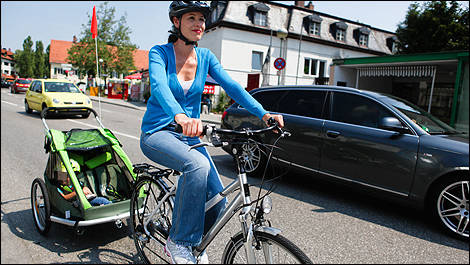A dedicated cyclist path, connecting the northern and southern extremities of the island of Montreal, is due to be fully operational between now and 2017. At last, cyclists can enjoy a safe ride without taking their chances on the mean city streets. Brilliant idea? For sure! Radical idea? Hardly.
The Dutch have long understood that the best way to ensure that bike and automobile co-exist harmoniously was to separate them. Holland was among the first to open up bike-only routes…given that every citizen of this country owns an average 1.11 bikes, this is no big surprise!
And Scandinavian countries are not to be outdone either: bike culture is well and truly implanted there as well. During my stay both in Sweden and Denmark in 2006, I was able to gauge the scale of this astonishing phenomenon. Here I am, a North American brought up with the idea that buzzwords like car and freedom are practically synonymous, suddenly discovering an environment where worship of the automobile is very far removed from the collective imagination.
At the railway station in Sweden, and for the first time in my life, I saw a parking lot for bikes only - not just a few dozen, but literally hundreds! In Copenhagen, I noticed that I was more likely to be knocked down by a bike that by a car. Getting around the city is geared towards cyclists and pedestrians, nobody seems to mind.
Business men and women, in suits, skirts, stiletto heels, sneakers…15,000 suburbanites commute to the downtown centre by bike, and that’s not counting those who already live in the city itself. Some of them rode tricycles equipped with a big front ‘basket’ to carry lunchboxes, briefcases or even kids. Recently, Copenhagen opened its first bike highway, and in a few years, the city should number 13 major bike paths, all connecting the suburbs with the downtown area.
Indeed, it’s quite the luxury: direct routes to the city centre, always free of snow and ice in winter, air pump stations for inflating tires approximately every 1.5 kilometres, rest areas (a bit like convenience stands at metro stations). Plus, these paths are not small: at least three metres wide, certainly wide enough for Tour de France wannabes and for a Zen-like sharing of the route (no road rage here).
It all sounds peachy but I’m asking myself that for a city as populated as Montreal, is it simply impossible? As of 2009, Copenhagen had 1,167,000 inhabitants. In Montreal, the population is 1,650,000 spread over a wider area...QED, say no more. But with so many cyclists, accident risk goes up as well, right? Actually, no.
We have to disconnect from our North American car culture perspective because in bike-friendly countries the number of accidents involving cars and bikes is proportionally less. Why? Because the cyclists stick to the dedicated bike paths. Keep in mind that cyclists ride on city streets because of the lack of an adequate bike path network. Overwhelmingly, most would prefer to ride along without constantly worrying about a car’s side mirror or the sudden opening of a car door.
Several big cities around the world have followed this trend to create paths and routes exclusively reserved for cyclists. No doubt about it, we still have plenty to learn from the North Europeans when it comes to the harmonious co-existence of cyclists and motorists.
The Dutch have long understood that the best way to ensure that bike and automobile co-exist harmoniously was to separate them. Holland was among the first to open up bike-only routes…given that every citizen of this country owns an average 1.11 bikes, this is no big surprise!
 |
And Scandinavian countries are not to be outdone either: bike culture is well and truly implanted there as well. During my stay both in Sweden and Denmark in 2006, I was able to gauge the scale of this astonishing phenomenon. Here I am, a North American brought up with the idea that buzzwords like car and freedom are practically synonymous, suddenly discovering an environment where worship of the automobile is very far removed from the collective imagination.
At the railway station in Sweden, and for the first time in my life, I saw a parking lot for bikes only - not just a few dozen, but literally hundreds! In Copenhagen, I noticed that I was more likely to be knocked down by a bike that by a car. Getting around the city is geared towards cyclists and pedestrians, nobody seems to mind.
Business men and women, in suits, skirts, stiletto heels, sneakers…15,000 suburbanites commute to the downtown centre by bike, and that’s not counting those who already live in the city itself. Some of them rode tricycles equipped with a big front ‘basket’ to carry lunchboxes, briefcases or even kids. Recently, Copenhagen opened its first bike highway, and in a few years, the city should number 13 major bike paths, all connecting the suburbs with the downtown area.
Indeed, it’s quite the luxury: direct routes to the city centre, always free of snow and ice in winter, air pump stations for inflating tires approximately every 1.5 kilometres, rest areas (a bit like convenience stands at metro stations). Plus, these paths are not small: at least three metres wide, certainly wide enough for Tour de France wannabes and for a Zen-like sharing of the route (no road rage here).
It all sounds peachy but I’m asking myself that for a city as populated as Montreal, is it simply impossible? As of 2009, Copenhagen had 1,167,000 inhabitants. In Montreal, the population is 1,650,000 spread over a wider area...QED, say no more. But with so many cyclists, accident risk goes up as well, right? Actually, no.
We have to disconnect from our North American car culture perspective because in bike-friendly countries the number of accidents involving cars and bikes is proportionally less. Why? Because the cyclists stick to the dedicated bike paths. Keep in mind that cyclists ride on city streets because of the lack of an adequate bike path network. Overwhelmingly, most would prefer to ride along without constantly worrying about a car’s side mirror or the sudden opening of a car door.
Several big cities around the world have followed this trend to create paths and routes exclusively reserved for cyclists. No doubt about it, we still have plenty to learn from the North Europeans when it comes to the harmonious co-existence of cyclists and motorists.


